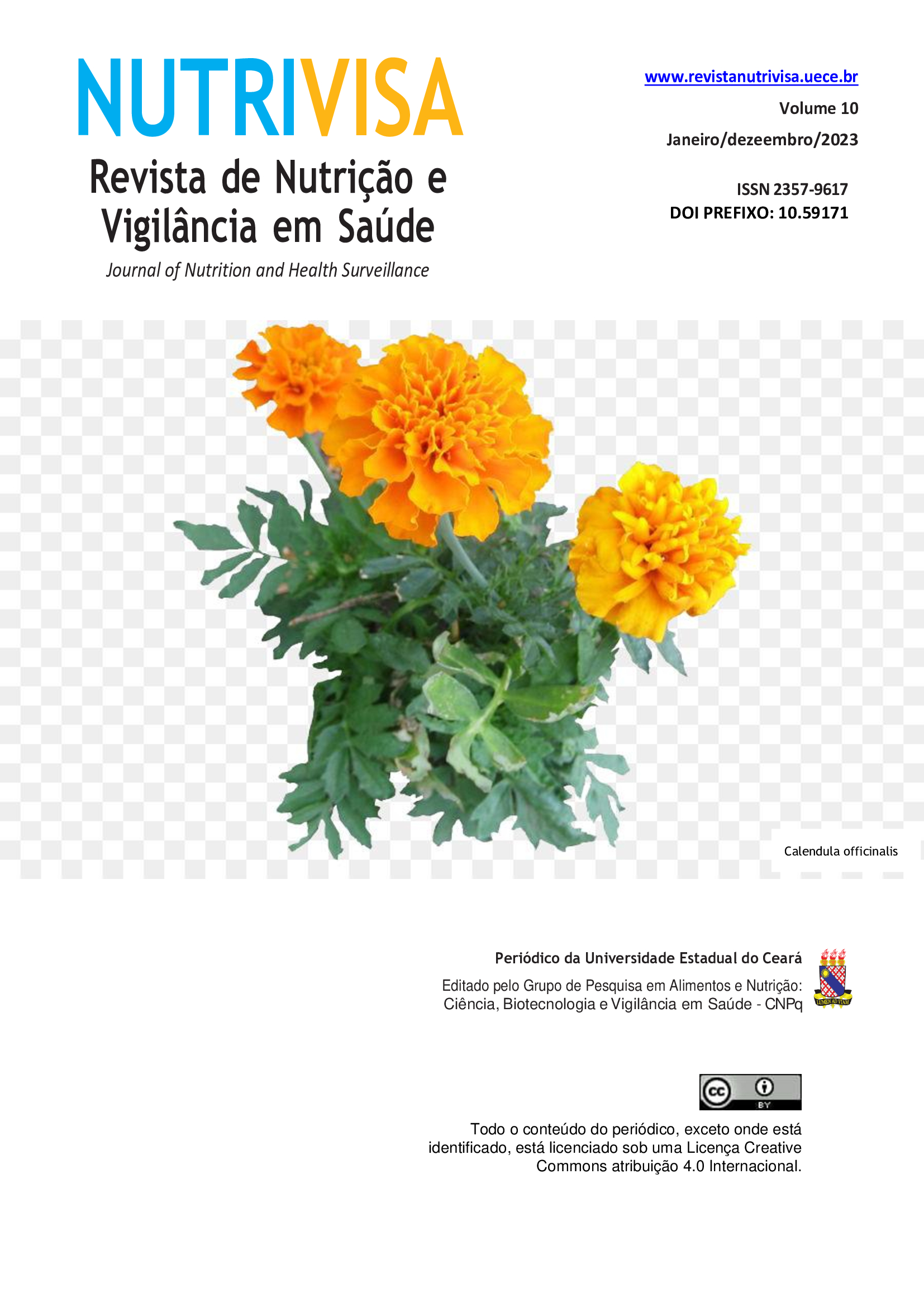Identification and quantification of bioactive compounds of brewery co-product, brewer's spent grain, and determination of antioxidant capacity
DOI:
https://doi.org/10.59171/nutrivisa-2023v10e10912Keywords:
Bioactive compounds. Brewer's spent grain. Antioxidant actividadAbstract
The solid residues in the beer manufacturing process are generated, mainly in the wort filtration stage, composed by remains of the peel and pulp of the grains, mixed, suspended or dissolved in the wort. Once most of phenolic compounds of the barley grain are in the peel, brewer's spent grain is then considered to be a potentially valuable source of phenolic compounds. These confer important antioxidant properties to the body, preventing some pathologies that involve the participation of free radicals. In this work we evaluated the content of phenolic compounds from brewer's spent grain by ultraviolet / visible spectrometry and the characterization of these compounds by high performance liquid chromatography (HPLC). The total phenol content in this extract was 1.06 ± 0.54 mg EAG / g extract and 0.24 ± 0.07 mg EQ / g extract for flavonoids. HPLC analysis revealed the presence of gallic acid (2.43 ± 0.04 mg / extract) and p-coumaric acid (0.16 ± 0.01 mg / g extract), known antioxidant compounds. The extract showed antioxidant activity of 23.17 mg/mL, that indicates the presence of constituents capable of capturing free radicals, as indicated by the HPLC analysis, characterizing this subproduct as a potential source of bioactive compounds.
References
ALIYU, S.; BALA, M. Brewer's spent grain: A review of its potentials and applications. African Journal of Biotechnology, Ethiopia, v.10, n.3, p.324–331, 2011.
ALMEIDA, A. R. Compostos bioativos do bagaço de malte: fenólicos, capacidade antioxidante in vitro e atividade antibacteriana. 2014. 76 f. Dissertação (Mestrado em Engenharia de Alimentos) – Programa de Pós-Graduação de Engenharia de Alimentos, Universidade Federal do Paraná, Curitiba, 2014.
ARRANZ, S.; CERT, R.; PÉREZ-JIMÉNEZ, J.; CERT, A.; SAURA-CALIXTO, F. Comparison between free radical scavenging capacity and oxidative stability of nut oils. Food Chemistry, Amsterdã, v. 110, n.4, p. 985-990, 2008.
ALMEIDA, A. R.; GERALDO, M. R. F.; RIBEIRO, L. F.; SILVA, M. V.; MACIEL, M. V. D. O. B.; HAMINIUK, C. W. I. Bioactive compounds from brewer’s spent grain: phenolic compounds, fatty acids and in vitro antioxidant capacity. Acta Scientiarum. Technology, Maringá, v.39, n.3, p.269-277, 2017.
ANDREASEN, M. F.; LANDBO, A. K.; CHRISTENSEN, L. P.; HANSEN, Å.; MEYER, A. S. Antioxidant effects of phenolic rye (Secale cereale L.) extracts, monomeric hydroxycinnamates, and ferulic acid dehydrodimers on human low-density lipoproteins. Food Chemistry, Amsterdã, v.49, n.8, p.4090-4096, 2001.
BALASUNDRAM, N.; SUNDRAMB, K.; SAMMAN. S. Phenolic compounds in plants and agriindustrial by-products: antioxidant activity, occurrence, and potential uses. Food Chemistry, Amsterdã, v. 99, n.1, p.191-203, 2006.
BORTOLOTTI, C. M. Caracterização de farinhas de cevada e o efeito da sua incorporação sobre a qualidade do pão de forma. 2009. 138 f. Dissertação (Mestrado em Ciência e Tecnologia de Alimentos) – Pós-Graduação em Ciência e Tecnologia de Alimentos, Universidade Federal de Santa Maria, Rio Grande do Sul, 2009.
BRAZ, J. M.; VIEIRA, A. A. Bagaço de cevada na alimentação animal. Revista eletrônica Nutritime, Viçosa, v.6. p. 973-979, 2009.
BRASIL. Ministério da Agricultura, Pecuária e Abastecimento. Indicações Técnicas para a Produção de Cevada Cervejeira nas Safras 2015 e 2016. Passo Fundo: Embrapa, 2015.
GARUD, M. S.; KULKARNI, Y. A. Gallic acid attenuates type I diabetic nephropathy in rats. Chemico-biological Interactions, Amsterdã, v. 282, p.69-76, 2018.
EHRHARDT, P.; SASSEN, H. A Cevada. Vassouras: Senai, 1995. 33 p.
FILLAUDEAU, L.; BLANPAIN-AVET, P.; DAUFIN, G. Water, wastewater and waste management in brewing industries. Journal of Cleaner Production., Lake Garda, v. 14, p.463-471, 2006.
FUNARI, C. S.; FERRO, V. O. Análise de própolis. Ciência e Tecnologia de Alimentos, Campinas, v. 26, n. 1, p. 171-178, 2006.
GALON, L.; FORTE, C.T.; KUJAWISKI, R.; RADUNZ, A. L.; DAVID, F. A.; PERIN, G.F.; CASTOLDI, C.T.; RADUNZ, L.L. Eficácia e fitotoxicidade de herbicidas aplicados para o manejo de plantas daninhas em cevada. Revista Brasileira de Herbicidas, Londrina, v.13, n.2, p.105-116, 2014.
GERON, L.J.V. Caracterização química, digestibilidade, fermentação ruminal e produção de leite em vacas alimentadas com resíduo de cervejaria nas rações. 2006. 116 f. Tese (Doutorado em Zootecnia) – Programa de Pós-Graduação em Zootecnia, Universidade Estadual de Maringá, Maringá, 2006.
HERNANDEZ, A. M., RODRÍGUEZ, J. L., LOPEZ, B., & ZERQUERA, O. L. Caracterización química y funcional del afrecho de malta. Alimentaria, Madrid, v.302, p.105-107, 1999.
HELM, C. V.; DE FRANCISCO, A. Chemical characterization of Brazilian hulness barley varietes, flour fracnation, and protein concentration. Scientia Agricola, Piracicaba, v. 61, n. 6, 2004.
KIKUZAKI, H., HISAMOTO, M., HIROSE, K., AKIYAMA, K., & TANIGUCHI, H. Antioxidant properties of ferulic acid and its related compounds. Journal of Agricultural and Food Chemistry, Amsterdã, v.50, n.7, p.2161-2168, 2002.
KOO, H.M.; SUHAILA, M. Flavonoid (myricetin, quercetin, kaempferol, luteolin, and apigenin) content of edible tropical plants. Jornal Agriculture Food Chemistry, Amsterdã, v.49, n. 6, p.3106-3112, 2001.
KIM, S.; JUN, C.; SUK, K.; CHOI, B.; LIM, H.; PARK, S., SEUNG HO LEE, HYE-YOUNG SHIN, DAE-KEUN KIM, TAE-YONG SHIN. Gallic acid inhibits histamine release and pro-inflammatory cytokine production in mast cells. Toxicological Sciences, England, v. 91, n. 1, p. 123-131, 2006.
MATOS, F.J. A. Introdução à Fitoquímica Experimental. Fortaleza: UFC, 1998. 150 p.
MATHIAS, T. R. S.; MELLO, PPM de; SERVULO, E. F. C. Caracterização de resíduos cervejeiros. In: CONGRESSO BRASILEIRO DE ENGENHARIA QUÍMICA, 20., 2014, Florianópolis. Anais... Florianópolis: COBEC, 2014. p. 1-8.
MCCARTHY, A. L.; O’CALLAGHAN, Y. C.; CONNOLLY, A.; PIGGOTT, C. O.; FITZGERALD, R. J.; O’BRIEN, N. M. Phenolic extracts of brewers’ spent grain (BSG) as functional ingredients–Assessment of their DNA protective effect against oxidant-induced DNA single strand breaks in U937 cells. Food chemistry, Amsterdã, v.134, n.2, p.641-646, 2012.
MELO, P. S. Composição química e atividade biológica de resíduos agroindustriais. 2010. 100 f. Dissertação (Mestrado em Ciência e Tecnologia de Alimentos) – Escola Superior de Agricultura Luiz de Queiroz, Universidade de São Paulo, Piracicaba. 2010.
MENESES, N.G.T; MARTINS S.; TEIXEIRA J.A; MUSSATTO S.I. Influence of extraction solvents on the recovery of antioxidant phenolic compounds from brewer's spent grains. Separation and Purification Technology, Portugal, v.108, p. 152-158, 2013.
MORAES, A. B. J.; COSTA, G. F.; SCHMIDT, B. Biodisponibilidade e classificação de compostos fenólicos. Nutrição Brasil, São Paulo, v. 18, n. 1, p. 39-48, 2019.
MOREIRA, M. M.; MORAIS, S.; CARVALHO, D. O.; BARROS, A. A.; DELERUE-MATOS, C.; GUIDO, L. F. Brewer's spent grain from different types of malt: Evaluation of the antioxidant activity and identification of the major phenolic compounds. Food Research International, Ottawa, v. 54, n.1, p. 382-388, 2013.
MOREIRA, M.M.; MORAIS S.; BARROS A.A.; DELERUE-MATOS C.; GUIDOL.F. A novel application of microwave-assisted extraction of polyphenols from brewer's spent grain with HPLC–DAD–MS analysis. Analytical and Bioanalytical Chemistry, v.403, n.4, p.1019-1029, 2012.
MORI, C.; MINELLA, E. Aspectos econômicos e conjunturais da cultura da cevada. Passo Fundo: Embrapa, 2012. 28 p.
MUTHUSAMY, N. Chemical Composition of Brewers Spent Grain – a Review. International Journal of Science, Environment and Technology, Índia, v.3, n. 6, p. 2109-2112, 2014.
PEREIRA, R. J.; CARDOSO, M. G. Metabólitos ssecundários vegetais e benefícios antioxidantes. Journal of Biotechnology and Biodiversity, v. 3, n. 4, p. 146-152, 2012.
NAGASAKA, R.; CHOTIMARKORN, C.; SHAFIQUL, I. M.; HORI, M.; OZAKI, H.; USHIO, H. Anti-inflammatory effects of hydroxycinnamic acid derivatives. Biochemical and Biophysical Research Communications, v.358, n.2, p.615-619, 2007.
OLIVEIRA, A. C.; VALENTIM, I. B.; GOULART, M. O. F.; SILVA, C. A.; BECHARA, E. J. H.; TREVISAN, M. T. S. Fontes vegetais naturais de antioxidantes. Química Nova, São Paulo, v. 32, n. 3, p. 689-702, 2009.
OLIVEIRA, D. M.; BASTOS, D. H. M. Biodisponibilidade de ácidos fenólicos. Química Nova, São Paulo, v. 34, n. 6, p. 1051-1056, 2011.
PINTADO, M. E.; TEIXEIRA, J. A. Valorização de subprodutos da indústria alimentar: obtenção de ingredientes de valor acrescentado. Boletim de Biotecnologia, Portugal, p.10-12, 2015.
RAUHA, J. P.; REMES, S.; HEINONEN, M.; HOPIA, A.; KAHKONEN, M.; KUJALA, T.; PIHLAJA, K; VUORELA, H.; VUORELA, P. Antimicrobial effects of Finnish plant extracts containing flavonoids and other phenolic compounds. International Journal of Food Microbiology, v.56, n.1, p.3-12, 2000.
SANTOS, M.; JIMÉNEZ, J. J.; BARTOLOMÉ, B.; GÓMEZ-CORDOVÉS, C.; DEL NOZAL, M. J. Variability of brewer’s spent grain within a brewery. Food Chemistry, Amsterdã, v.80, n.1, p.17-21, 2003.
SKOOG, J.; HOLLER, F. D. A.; CROUCH, S. R. Princípios de análise instrumental. Porto Alegre: Bookman, 2009. 91 p.
SAIBABU, V.; FATIMA, Z.; KHAN, L. A.; HAMEED, S. Therapeutic potential of dietary phenolic acids. Advances in pharmacological sciences, n.1, p. 1-10, 2015.
SOUSA, C. D. M.; SILVA, H. R.; VIEIRA-JR, G. M.; AYRES, M. C. C.; COSTA, C. D.; ARAÚJO, D. S.; CAVALCANTE, L. C. D.; S. BARROS, E. D.; M. ARAÚJO, P. B.; BRANDÃO, M.S.; CHAVES, M. H. Fenóis totais e atividade antioxidante de cinco plantas medicinais. Química Nova, São Paulo, v. 30, n. 2, p. 351-355, 2007.
STEFANELLO, F. S.; FRUET, A. P. B.; SIMEONI, C. P.; CHAVES, B. W.; DE OLIVEIRA, L. C.; NÖRNBERG, J. L. Brewers’spentgrain: bioactivity of phenolic compounds; applicability in animal nutrition and functional foods. Revista Eletrônica em Gestão, Educação e Tecnologia Ambiental, Santa Maria, v.18, p.1-10, 2014.
SZWAJGIER, D.; WAŚKO, A.; TARGOŃSKI, Z.; NIEDŹWIADEK, M.; BANCARZEWSKA, M. The use of a novel ferulic acid esterase from Lactobacillus acidophilus K1 for the release of phenolic acids from brewer's spent grain. Journal of the Institute of Brewing, v.116, n.3, p.293-303, 2010.
SCHERER, R.; WAGNER, R.; DUARTE, M. C. T.; GODOY, H. T. Composição e atividades antioxidante e antimicrobiana dos óleos essenciais de cravo-da-índia, citronela e palmarosa. Revista Brasileira de Plantas Medicinais, Botucatu, v. 11, n. 4, p. 442-449, 2009.
KILIC, K.; SAKAT, M. S.; AKDEMIR, F. N. E.; YILDIRIM, S.; SAGLAM, Y. S.; ASKIN, S. Protective effect of gallic acid against cisplatin-induced ototoxicity in rats. Brazilian Journal of Otorhinolaryngology, v. 85, n.3, p.267-274, 2019.
VENTURINI FILHO, W. G. Bebidas Alcoolicas: ciência e tecnologia. 2. ed. São Paulo: Blucher, 2016. 492 p.
YALÇIN, E.; CELIK, S.; AKAR, T.; SAYIM, I.; KOKSEL, H. Effetcs of genotype and environment on b-glucan and dietary fiber contents of hull-less barley grown in Turkey. Food Chemestry, Turkey, v. 101, p. 171-176, 2007.
YEPEZ, B.; ESPINOSA, M.; LÓPEZ, S.; BOLANOS, G. Producing antioxidant fractions from herbaceous matrices by supercritical fluid extraction. Fluid Phase Equilibria, v.194, p. 879-884, 2002.
YOSHIDA, H.; KISUGI, R. Mechanisms of LDL oxidation. Clinica Chimica Acta, v. 411, p. 1875-1882, 2010.
Downloads
Published
How to Cite
Issue
Section
License
Copyright (c) 2023 Clécio Galvão Martins, Selene Maia de Morais, Ana Livya Moreira Rodrigues , Cristiane Duarte Alexandrino Tavares, Jorgiane da Silva Severino Lima

This work is licensed under a Creative Commons Attribution 4.0 International License.














